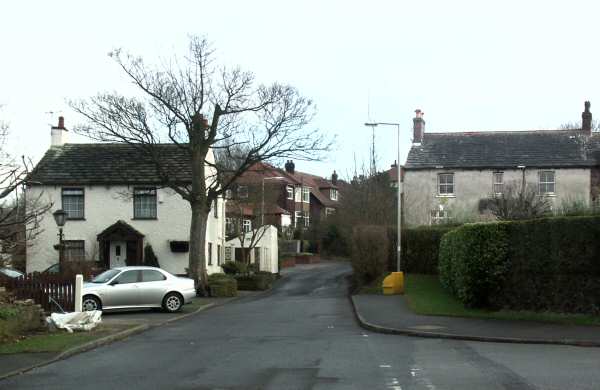


| Two old buildings on Poleacre Lane, left Woodhey Cottage, right Poleacre Farm. |

| The same buildings from the rear, the farm on the left. The road is paved with sets. |

| The old farmyard at Poleacre farm, viewed from the lane. |
The farm appears to have kept cows and a few pigs. During the industrial revolution it would have made a good living supplying milk and meat to nearby industrial towns which were expanding rapidly. Even after the 1840s, when trains brought milk from further afield, local villages such as Woodley expanded and provided more local custom for the farm. Throughout its history there would have been good times and bad times. It would have been effected by the plagues of rinderpest, foot and mouth disease, and swine fever. During the 20th century the need for food, particularly during the two world wars, kept the farm going, but land was taken for house building. Eventually, by the end of the century, expanding towns swamped the farm, making it no longer viable.
In 2005 when this web page was created it looks forlorn, perhaps inhabited by a retired farmer. Sometime not far away it will be demolished or completely renovated. The farmyard and small amount of remaining land will be used for new housing.
In 1765 the Stockport to Mottram turnpike was built by blind John Metcalfe. It follows the line of the lane for a short way, but where the lane takes a meander to the north-west, the new turnpike cut straight uphill. This left a bight of lane unchanged. That became the Poleacre Lane of today. It leaves the turnpike (now the A560 Hyde Road) in Woodley, mid way up the hill, and rejoins the main road after a quarter of a mile, at the top of the hill, near the boundary with Hyde. The farm and cottage are half way along the lane. The 1841 map also shows a terrace of eight workers cottages at the bottom of the lane. They still exist.
In 1799 a section of the Peak Forest canal was cut. It skirts round the bottom of the hill about a quarter of a mile from the farm.
In the early 1800s Polebank Hall was built on the turnpike not far from the top of Poleacre Lane. In 1831 it was the scene of a murder. Thomas Ashton, a mill owner's son, was killed by angry employees.
In 1860 the Trianon, a large cotton spinning mill, was built between the canal and the farm, with road access from Poleacre Lane just below the farm. This probably accounts for the lane being paved with sets, unusual for a country lane. It was not a good time to open a cotton mill. The cotton famine caused by the American civil war lasted from 1861 to 1865. The Trianon, also known as the Unity, soon turned to processing rubber.
Also in 1860 the Manchester to Rose Hill railway was cut alongside the lower half of Polebank Lane, causing the lane to be straightened. Woodley railway station opened on the main road near the bottom of the lane. The railway was constructed by the Manchester, Sheffield, and Lincolnshire Railway Company (the MSL), eventually nicknamed the Money Sunk and Lost.
In 1903 electric trams started to run along the main road en route between Stockport and Hyde.
At various times during the 20th century new houses were built along the whole length of the lane, thus it changed from a rural to an urban environment.
In 1974, the area was taken out of the county of Cheshire, and put into Stockport MB in the new county of Greater Manchester.